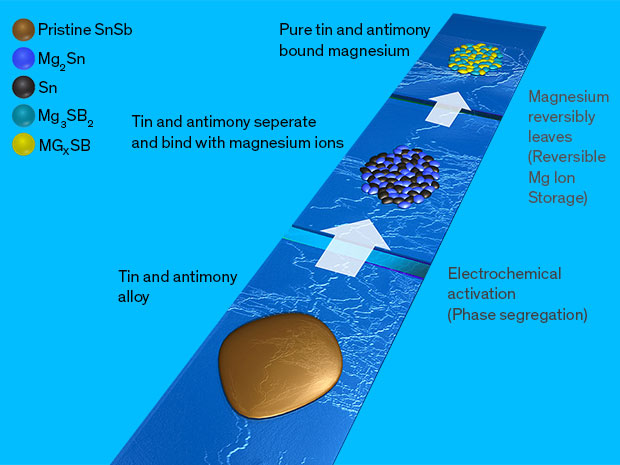It was at the onset of 2014 when a Boeing Dreamliner aircraft met with fire because of ignition of the lithium in the rechargeable batteries. It made it clear that Li-ion batteries have few fundamental safety issues with them, and these issues need to be corrected as soon as possible.
One great alternative to the Li-ion batteries is the magnesium-ion battery that is proven not to incorporate the similar safety issue. However, it is a struggle to produce robust electrodes for magnesium batteries that are endurable and can perform efficiently for a much longer duration.
Presently, scientists at the Department of Energy’s Pacific Northwest National Laboratory (PPNL) are hunting out for an alloy made out of antimony and tin that may possess the secret to make the magnesium-ion battery a more feasible alternative to the Li-ion battery. The antimony or tin allow been considered as a lucrative material for the electrodes of magnesium-ion batteries with a speculative capacity of 768 mill amperes per hour per gram.

According to the detailed description of the research, the researchers of the PNNL team unveiled that once linked together in an alloy, the Antimony and Tin particles create porous networks of antimony-rich and tin-rich sub-particles. The regions with tin-rich portions work great as an electrode material while the antimony-rich regions are not so much high performing.
Nevertheless, the antimony areas play a crucial role in creating the alloy as effective as an electrode material by avoiding the Tin from disintegrating at the intersection between two materials. As far as the functionality of a magnesium-ion battery is concerned, it employs this alloy that is the magnesium ions would be allowed to move into the Tin space and then, later on, leave the area. Without prevalence of any antimony in that region, the tin would breakdown soon after the magnesium ions deviated. It is a fact that the antimony cannot discharge or receive the magnesium ions that make it turn out to be a poor electrode material. Based on this fact the Tin alloy is a much better material for the electrode.
This research is useful to introduce to the world the different structures that can be used for energy technologies. It is an extensive research program that is still going on as the final results are still to be concluded. According to the Yuyan Shao, one of the panel members of the research team of PNNL, “This research provides extremely important information on the procedure to begin with an alloy and generate a phase-separated material with a distinct structure. Such a structure will be useful and beneficiary for the energy technologies.”
Conclusion – As the research concludes, conventionally only Li-ion batteries were used to meet different energy technologies demand, but it was not a hundred percent safe solution. But with the introduction of a unique alloy combination, it is expected that things will now streamline, and high-performing, and completely secured end results will be now attainable.
Filed Under: News


Questions related to this article?
👉Ask and discuss on Electro-Tech-Online.com and EDAboard.com forums.
Tell Us What You Think!!
You must be logged in to post a comment.